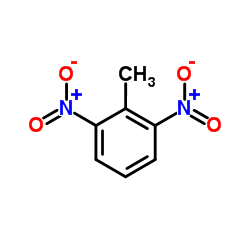2,6-Dinitrotoluene

2,6-Dinitrotoluene structure
|
Common Name | 2,6-Dinitrotoluene | ||
|---|---|---|---|---|
| CAS Number | 606-20-2 | Molecular Weight | 182.133 | |
| Density | 1.4±0.1 g/cm3 | Boiling Point | 278.2±20.0 °C at 760 mmHg | |
| Molecular Formula | C7H6N2O4 | Melting Point | 56-61 °C(lit.) | |
| MSDS | Chinese USA | Flash Point | 130.6±14.6 °C | |
| Symbol |


GHS07, GHS08 |
Signal Word | Danger | |
|
Study of the Behaviors of Gunshot Residues from Spent Cartridges by Headspace Solid-Phase Microextraction-Gas Chromatographic Techniques.
J. Forensic Sci. 60 , 869-77, (2015) Gunshot residues, produced after shooting activity, have acquired their importance in analysis due to the notoriety of firearms-related crimes. In this study, solid-phase microextraction was performed to extract the headspace composition of spent cartridges u... |
|
|
Electrochemical characterization of riboflavin-enhanced reduction of trinitrotoluene.
Sensors (Basel.) 11(11) , 10840-50, (2011) There is great interest in understanding trinitrotoluene (TNT) and dinitrotoluene (DNT) contamination, detection and remediation in the environment due to TNT's negative health effects and security implications. Numerous publications have focused on detecting... |
|
|
Micellar electrokinetic chromatography of organic and peroxide-based explosives.
Anal. Chim. Acta 876 , 91-7, (2015) CE methods have been developed for the analysis of organic and peroxide-based explosives. These methods have been developed for deployment on portable, in-field instrumentation for rapid screening. Both classes of compounds are neutral and were separated usin... |
|
|
Electrochemical destruction of dinitrotoluene isomers and 2,4,6-trinitrotoluene in spent acid from toluene nitration process.
J. Hazard. Mater. 161(2-3) , 1017-23, (2009) Mineralization of dinitrotoluene (DNT) isomers and 2,4,6-trinitrotoluene (TNT) in spent acid was conducted by in situ electrogenerated hydrogen peroxide. The electrolytic experiments were carried out to elucidate the influence of various operating parameters ... |
|
|
Evaluation of the dependence of aqueous solubility of nitro compounds on temperature and salinity: a COSMO-RS simulation.
Chemosphere 83(3) , 287-94, (2011) The solubility in pure and saline water at various temperatures was calculated for selected nitro compounds (nitrobenzene, 1,3,5-trinitrobenzene, 2-nitrotoluene, 3-nitrotoluene, 4-nitrotoluene, 2,4-dinitrotoluene, 2,6-dinitrotoluene, 2,3-dinitrotoluene, 3,4-d... |
|
|
Determination of 2,4- and 2,6-dinitrotoluene biodegradation limits.
Chemosphere 85(5) , 848-53, (2011) This study was carried out to explore the lowest achievable dinitrotoluene (DNT) isomer concentrations that would support sustained growth of DNT degrading microorganisms under an aerobic condition. Studies were conducted using suspended (chemostat) and attac... |
|
|
Noninvasive detection of concealed explosives: depth profiling through opaque plastics by time-resolved Raman spectroscopy.
Anal. Chem. 83(22) , 8517-23, (2011) The detection of explosives concealed behind opaque, diffusely scattering materials is a challenge that requires noninvasive analytical techniques for identification without having to manipulate the package. In this context, this study focuses on the applicat... |
|
|
2,4-Dinitrotoluene, 2,6-dinitrotoluene and 3,5-dinitrotoluene.
IARC Monogr. Eval. Carcinog. Risks Hum. 65 , 309-368, (1996)
|
|
|
A structural modelling study on marine sediments toxicity.
Mar. Drugs 6(2) , 372-88, (2008) Quantitative structure-activity relationship models were obtained by applying the Molecular Descriptor Family approach to eight ordnance compounds with different toxicity on five marine species (arbacia punctulata, dinophilus gyrociliatus, sciaenops ocellatus... |
|
|
Matrix compatible solid phase microextraction coating, a greener approach to sample preparation in vegetable matrices.
Food Chem. 206 , 67-73, (2016) This work proposes the novel PDMS/DVB/PDMS fiber as a greener strategy for analysis by direct immersion solid phase microextraction (SPME) in vegetables. SPME is an established sample preparation approach that has not yet been adequately explored for food ana... |